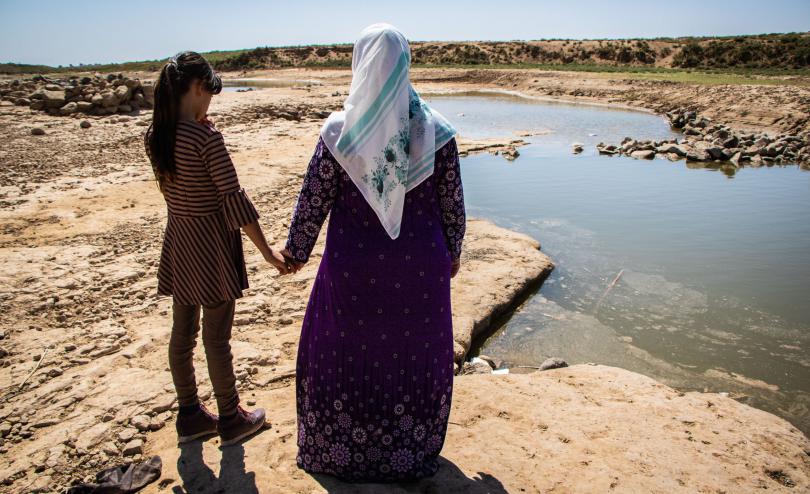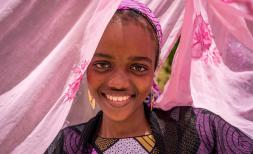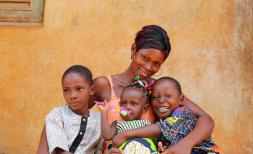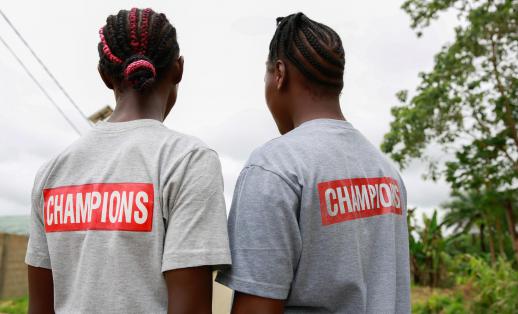How to talk to children about climate change

Bailasan*, 13, and her mother, Maryam*, look out onto the river after drought caused a water crisis in North East Syria.
The climate change is the defining crisis of our time – and the rights and futures of children are disproportionately at risk. Have the children in your life asked you some tough questions about the climate crisis? Have they asked you 'what is climate change?' or 'why is climate change important?' or even 'how is climate change affecting people?'
If so, you have come to the right place. To help parents, teachers, caregivers and adults everywhere to navigate potentially difficult conversations, Save the Children has worked with our UK Youth Advisory Board to come up with five top tips on how to speak to children about climate change. Here’s their advice:
Hear them out
Children and young people are aware that the climate crisis will uniquely impact their generation. Make time and hold space for them to share how they’re feeling and discuss their concerns and hopes for the future. Like one 17-year-old boy told us, adults need to “be serious about resolving [climate change]” - and this starts with adults listening to and learning from what children are telling us. Don’t underestimate their ability to ask tough questions, propose smart solutions, and teach you something, too.
It’s okay that we might not have all the answers, or that we, as adults, might feel worried about children’s futures. What’s most important is that we commit to staying informed and creating open and honest conversations about climate change with children both inside and outside of their school classrooms.
Rely on science
Disinformation has spread faster and with wider reach in the digital age – and it can ultimately undermine meaningful climate action.
Having responsible conversations about the climate crisis with children and young people means ensuring that these conversations are informed by the scientists and climate researchers who know best. There is a wealth of information out there if you would like to feel more clued up on the root causes of climate change and the systemic change needed for safer, greener futures for children. These United Nations fact sheets or Save the Children’s ‘Born into the Climate Crisis’ report are both good places to start.
Tailor the conversation to the child
Be mindful of the child’s age and capacity to understand complex issues before speaking to them about climate change. Encourage them to decide how they would like to discuss or learn more about the topic.
Younger children are likely to still be developing their understanding of the outside world. Start with the basics and discuss what could help the environment, such as planting trees and clean oceans, and what’s harmful, like rising temperatures and plastic pollution. Connecting with nature is an important step in building an understanding of climate change, so consider having these conversations outdoors if you’re able to. Older children may already have a more advanced understanding of climate change. Encourage them to see beyond their immediate environment and understand that, as one 15-year-old boy put it:
[the climate crisis] is a global problem and we need to all work together” to solve it.
Check out this helpful list of the best picture books and older fiction titles to help children of all ages learn about climate change.
Make clear it’s not their problem to solve
Studies have shown that climate anxiety is impacting the day-to-day lives of children and young people in countries across the world. In the UK, a vast majority of children we spoke to said that they are worried about the world they will inherit.
Whilst not sugar-coating the challenges that lie ahead of us, it’s important to remind children that the responsibility of solving the climate crisis does not lie with them. Be an ally to children who are carrying a huge burden on their shoulders that isn’t of their making by: acknowledging that their concerns are valid, reassuring them that they are safe, and reminding them that there are adults around the world who are passionately working to see an end to climate change.
Take action together
Where there are crises, there is always hope that change is possible. Take it from one 14-year-old girl:
my generation cares and can change things.”
Inspire children to see themselves as agents of change and together explore options for change making that feel accessible, impactful and fun. Share this blog with your friends and family and help them have these conversations with the children in their life too.
Would you like to take further action and help children around the world facing the climate crisis? Help us to be there for the children who are already being affected by climate change by making a monthly donation.
Around 1 billion children, roughly 1 in 2 children on the planet, live in countries at ‘extreme risk’ from the impacts of climate change. Make no mistake the climate crisis is a child rights crisis.
What we are doing
Right now our teams are supporting children and families on the frontline of the climate crisis by ramping up our humanitarian response. This includes providing water for communities battling drought, therapeutic food for malnourished children as well as cash and vouchers for families whose livelihoods have been hit hard by the impacts of climate change. Become a monthly donor and protect the lives of children.







